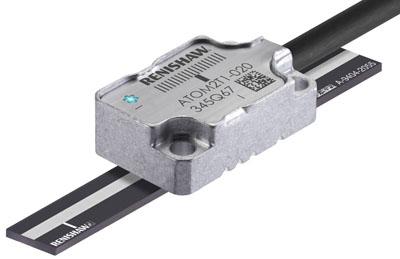
Renishaw's new ATOM non-contact optical linear and rotary incremental encoder system combines miniaturization with leading-edge dirt immunity, signal stability and reliability. With a readhead as small as 6.7 x 12.7 x 20.5mm, ATOM miniature encoder uses filtering optics with Auto Gain Control (AGC) and Auto Offset Control (AOC) for exceptional signal stability and dirt immunity, according to the company. Applications include laser scanning, precision micro stages, semiconductor, medical, DDR motors, microscopy, scientific research and space-critical motion control, inspection and metrology.
The ATOM system delivers low Sub-Divisional Error (SDE), low jitter and long-term reliability. ATOM offers analog speeds to 20 m/s (29,000 RPM on a 17mm disc) and digital resolutions to 1 nm when used with Renishaw interpolation electronics. The readhead includes a set-up LED to allow quick and easy installation, and an auto-calibration routine to enable faster optimization. Scale options include linear and rotary (angle) scales in stainless steel and glass.
The compact ATOM readhead is available with either high-flex cable or Flexible-Printed Circuit (FPC) output, in both 20and 40µm scale options, with ultra-compact interface electronics in ACi and Ri options. The FPC variant reduces the overall package size and allows integration with ACi. A variety of high-accuracy scales is available, including industry-standard stainless steel tapes, high accuracy linear glass spars and rotary glass discs from 17 to 108mm in diameter.
Optional interfaces support interpolation factors to x 20,000, allowing outstanding metrology and unmatched dynamic performance. Designers can also use the sinusoidal signal output from the readhead for direct connection to analog drives and controllers.
ATOM is CE-approved and manufactured in-house at Renishaw under quality controls certified to ISO 9001:2008.
Contact Details
Related Glossary Terms
- interpolation
interpolation
Process of generating a sufficient number of positioning commands for the servomotors driving the machine tool so the path of the tool closely approximates the ideal path. See CNC, computer numerical control; NC, numerical control.
- metrology
metrology
Science of measurement; the principles on which precision machining, quality control and inspection are based. See precision machining, measurement.
